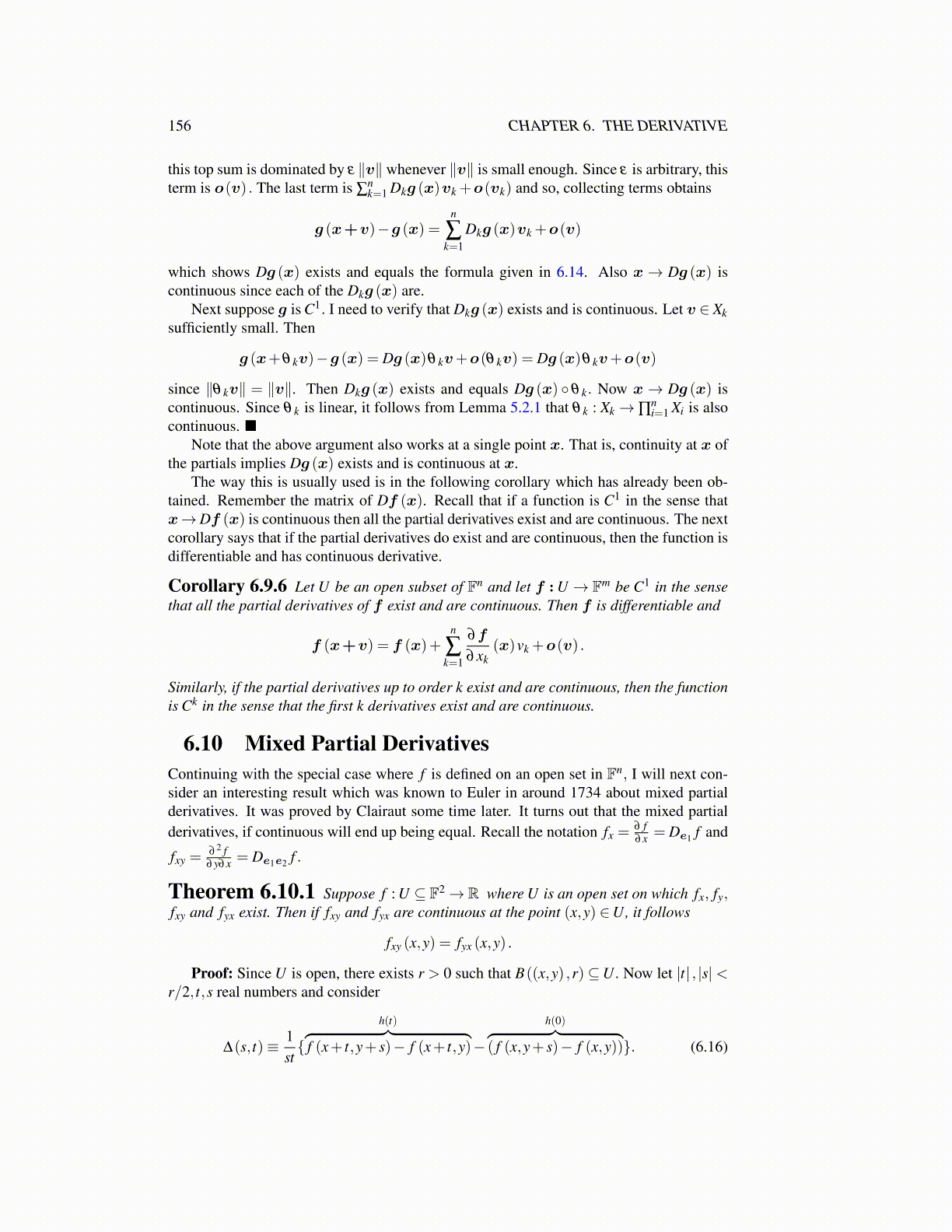
156 CHAPTER 6. THE DERIVATIVE
this top sum is dominated by ε ∥v∥ whenever ∥v∥ is small enough. Since ε is arbitrary, thisterm is o(v) . The last term is ∑
nk=1 Dkg (x)vk +o(vk) and so, collecting terms obtains
g (x+v)−g (x) =n
∑k=1
Dkg (x)vk +o(v)
which shows Dg (x) exists and equals the formula given in 6.14. Also x→ Dg (x) iscontinuous since each of the Dkg (x) are.
Next suppose g is C1. I need to verify that Dkg (x) exists and is continuous. Let v ∈ Xksufficiently small. Then
g (x+θ kv)−g (x) = Dg (x)θ kv+o(θ kv) = Dg (x)θ kv+o(v)
since ∥θ kv∥ = ∥v∥. Then Dkg (x) exists and equals Dg (x) ◦ θ k. Now x→ Dg (x) iscontinuous. Since θ k is linear, it follows from Lemma 5.2.1 that θ k : Xk→∏
ni=1 Xi is also
continuous. ■Note that the above argument also works at a single point x. That is, continuity at x of
the partials implies Dg (x) exists and is continuous at x.The way this is usually used is in the following corollary which has already been ob-
tained. Remember the matrix of Df (x). Recall that if a function is C1 in the sense thatx→Df (x) is continuous then all the partial derivatives exist and are continuous. The nextcorollary says that if the partial derivatives do exist and are continuous, then the function isdifferentiable and has continuous derivative.
Corollary 6.9.6 Let U be an open subset of Fn and let f :U → Fm be C1 in the sensethat all the partial derivatives of f exist and are continuous. Then f is differentiable and
f (x+v) = f (x)+n
∑k=1
∂f
∂xk(x)vk +o(v) .
Similarly, if the partial derivatives up to order k exist and are continuous, then the functionis Ck in the sense that the first k derivatives exist and are continuous.
6.10 Mixed Partial DerivativesContinuing with the special case where f is defined on an open set in Fn, I will next con-sider an interesting result which was known to Euler in around 1734 about mixed partialderivatives. It was proved by Clairaut some time later. It turns out that the mixed partialderivatives, if continuous will end up being equal. Recall the notation fx =
∂ f∂x = De1 f and
fxy =∂ 2 f∂y∂x = De1e2 f .
Theorem 6.10.1 Suppose f : U ⊆ F2→ R where U is an open set on which fx, fy,fxy and fyx exist. Then if fxy and fyx are continuous at the point (x,y) ∈U, it follows
fxy (x,y) = fyx (x,y) .
Proof: Since U is open, there exists r > 0 such that B((x,y) ,r)⊆U. Now let |t| , |s|<r/2, t,s real numbers and consider
∆(s, t)≡ 1st{
h(t)︷ ︸︸ ︷f (x+ t,y+ s)− f (x+ t,y)−
h(0)︷ ︸︸ ︷( f (x,y+ s)− f (x,y))}. (6.16)